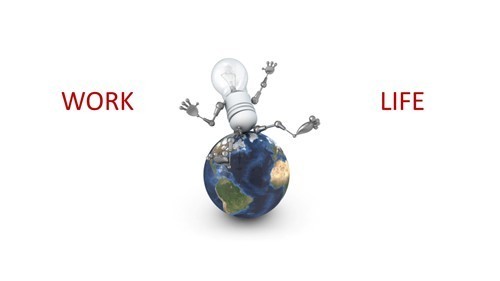Follow this carefully:
The number of days in a year is: 365
Sleeping 8 hours a day is: 122which leaves: 243
52 weekends - two days (Saturday and Sunday) is: 104which leaves: 139
Three weeks’ holiday is: 21which leaves: 118
Easter holidays and May Bank Holidays take another: 4which leaves: 114
An hour for showering, breakfast, getting ready, etc: 15which leaves: 99
Two hours’ commuting is: 30which leaves: 69
One hour on lunchbreak is: 15which leaves: 54
Half an hour for coffee breaks, toilet trips, shopping, etc.: 7which leaves: 47
One hour for your evening meal (preparing, eating, clearing away, etc.): 15which leaves: 32
One hour for emails, phone calls, social media: 15which leaves: 17
One hour for television: 15which leaves: 2
Christmas Day and Boxing Day take up: 2which leaves: 0
This leaves 0 days for working! So why are you worried about work-life balance?
Okay, so the logic is flawed and with a bit of thought you can see how you can quickly be fooled into thinking a certain way.
So why isn’t this logic applied to the concept of work-life balance?
Work-life balance is hard no matter who you are, how long your commute is or what kind of work you do. Why? Because work-life balance is a big hoax! The more you believe in it, the more miserable you become.
Think about it. The phrase is actually meaningless. Life is not at one end of a fulcrum with work on the other end. There is no separation between “work” and “life.” “Work” and “life” aren’t binary and “life” is much more complex than “non-work.” This myth continues to be perpetuated with the phrase being dropped into conversation without any thought around the logic of what is being said.
The issue with the phrase “work-life balance” is that it compartmentalises everything into work activities (meetings, clients, trips, conferences) and life activities (family commitments, holidays, hobbies, keeping healthy).
Work is an integrated part of life. You only have one life – you just happen to live some of it while working and some of it engaged in other activities. Like most people over the age of 20, work takes up a major proportion of your life and has to be realistically integrated into all of your activities to give you a rich, rewarding and meaningful focus. It is all about personal organisation and finding ways to relax.
“Balance” is dynamic, not static. Finding balance means that “work” and “life” varies, sometimes on a daily basis. Balance is not a state of being. Balance is the fulcrum: the dynamic middle point of push and pull. Balance means shifting with the priorities of the day, week, month and year and accepting that.
Being balanced is not about being static. It’s a process requiring constant adjustments, decisions, and corrections so that you can respond to opportunities and challenges.
Also, a balanced day doesn’t necessarily mean that you have to accomplish more in less time. Through the practise of mindfulness, you can learn to slow down in order to speed up; to evaluate what matters and reallocate time to those things.
Stop believing in the fallacy that is work-life balance. It’s a false mind-set. Instead, come to terms with the flux. Know that some days will feel more balanced than others.
The author of this article, Robin Hills, is managing director of Ei4Change. Ei4Change is a Lancashire based company teaching a range of online emotional intelligence courses to 250,000+ students in over 190 countries (June 2021). Ei4Change have a range of emotional intelligence online courses approved by The Institute of Leadership and Management. Further details about the range of online emotional intelligence courses can be found here - courses.ei4change.info























